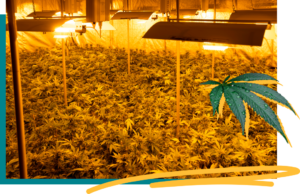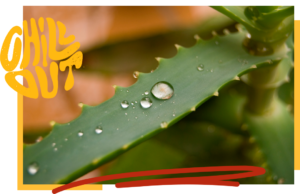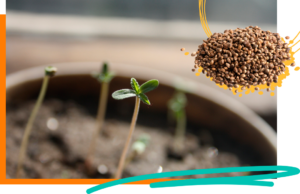Terms with a spyglass icon are defined at the bottom of the blog.
The Beans-to-Greens Grow Guide: Step 3
Step 3 of 6: Maintain the seedlings

The Funky Beans Method
Vibrant green, funky little sprouts that spring from your starter pot; healthy seedlings means you’re on your way to a healthy, mature plant.
By this point in the process, you’ve germinated and planted your seeds (check out Steps 1 and 2, respectively, for details on each of these stages). 1-3 days after planting your seed, you should see a stalk with two small, rounded embryonic leaves called cotyledons. With the appearance of this sprout, you have yourself a seedling.
Now it’s time to dig in and focus on botanical basics: light, water, humidity, and temperature. This step will be all about helping your plant get cozy in its growing environment, while it establishes a robust root zone.
Whether you’re growing autoflower, feminized, or regular plants, your treatment of the seedlings will be about the same across the board. We recommend executing this step inside, or in a greenhouse, even if you are growing outdoor-bound plants. This is so that you can control the plant’s environment during its most vulnerable phase.
Stuff You’ll Need

And, while we are keeping the need for specialized tools to an absolute minimum for the average home-grower, keep an eye out for a couple of pieces of equipment that will really make your life easier in the long-run:
Light
A note on PAR value: Photosynthetic Active Radiation (PAR) measures the range of light in which plants can grow, identified as micromoles of light per square meter per second (umol/s). Essentially, this reading indicates the strength of light your plants are absorbing. We use this PAR meter to measure ours.
Additionally, we recommend using either LED or CFL bulbs for this step. To adjust the light emission, either manually raise or lower the light or use a mechanized controller to reduce the wattage.
- LED lights
For simple, at home growing, LED lights are effective. You will, however, need to keep them 12 to 18 inches away from the plants to avoid overheating or drying them out. So, consider tracking down CFL lights if indoor grow space is a limiting factor for you. - CFL grow lights
Compact Fluorescent bulbs (CLFs) are easy to find and don’t burn as hot as standard bulbs. You’ll need both soft white and daylight bulbs to fulfill your plant’s full spectrum needs, especially if you’re planning to grow entirely indoors. T5 bulbs, in particular, are known for their weed-vegging capabilities. - Infrared temperature gun
For monitoring the surface temperature of the leaves, having this value will help you keep track of the Vapor Pressure Deficit (VPD, discussed in detail a little later), as well as ensure that your leaves are not being overexposed to light. - Humidistat & Thermometer
We recommend acquiring this device, which measures the temperature, relative humidity %, VPD, PAR, Co2, and more.
For a cheaper way to measure the temperature and relative humidity %, we like this device. It connects to wifi and can be monitored remotely. You’ll just have to do some math (as mentioned below) if you want to calculate the VPD. - Water with supplements
We widely employ the application of two supplements in a water solution, detailed in Step 2 of this blog series. - Organic Aloe Vera Flakes Check out ours!
- Soil-Activating Mycrobes (mykros) Check out ours!
Let’s maintain (not kill) those seedlings

It’ll be a matter of treating your seedlings like the delicate lil’ babies that they are. Here are some tips to keep them happy:
Lighting
- Give your plants at least 16 hours of sunlight over 24 hours.
- Using a PAR light meter, keep the value range between 100 to 199 umol/s for optimal seedling growth.
- Keep the seedlings from getting burned or overheated by their lights using these methods:
- With your infrared temperature gun, check that the surface temperature of the leaves is in the range of 75-80°F.
- If you don’t have a temp gun, hold your hand the same distance from the bulb as your plants would be placed. If it feels hot after about 10 seconds, your light is too close. Repeat this inch by inch, until it feels comfortable.
- Look for signs of stretching, which happens when the light source is too far away from the plant and it needs to reach and stretch to get closer. This results in long, weak stems with lower weight-bearing capacity.

Vapor Pressure Deficit (VPD)
- By monitoring the VPD value, you will be able to evaluate and ensure that the conditions are ideal for maximizing the plants’ ability to transpirate and grow.
- Transpiration is the process by which plants are able to move moisture through their systems by way of a pressure deficit relative to the pores (stomata) of the leaves.
- The VPD is a calculation of the relationship between the Saturated Vapor Pressure (of the plant) and the Vapor Pressure of the air.
- If you’re using the VPD valuation system, the ideal VPD value for this stage is 1-1.4.
- You’ll be able to achieve this value by maintaining conditions at 82°F, 70%RH, & a PAR light value at 200 umol/s.

Water
- For a full work-up on diluting the Organic Aloe Vera Flakes and Soil-Activating Mycrobes (mykos) solution, check out Step 2 of 6. But here’s the jist:
- Activate mykos at least 30 minutes before application by letting them bloom in water.
- Add the aloe flakes to the same water and mix together to create a solution.
- Lightly water your seedlings about every two to three days, or as needed, with this solution. Your goal is to keep the topsoil moist.
Looks like you might be ready for Step 4 of 6

Happy seedlings make happy adult plants. This presents an opportunity to cull your crop, keeping an eye out for any weak players who aren’t showing a real vigor for life. The same is true throughout the rest of the growing phase for your plants.
Those that pass your inspection are on their way to the early vegetative stage (usually one to two weeks from the initial sprout). Branching stems and sprouting leaves that are developing their characteristic serrated fingers means you’re ready for the next blog in this 6-part series, Bulk the veg-gals.
Like the look of your crop? You can automatically order more of these seeds with our one-click autoship service. Before you “bag your beans,” select Autoship, then choose whether you want to receive them every 1, 3, or 6 months. The best part? You’ll get to buy them at a 20%, 15%, or 10% discount, respectively.
Make sure you’re enrolled in our Funky Beans rewards program , so you can earn CannaCredits with every autoship order. Opting out of autoshipping? You can still earn CannaCredits each time you shop, share content, or even have a birthday. You’ll even get exclusive access to our private Funky Beans Facebook group for some dope community intel. Did we just become best BUDS?










 Instagram
Instagram